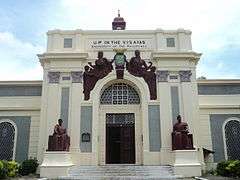University of the Philippines Visayas Tacloban College
The University of the Philippines Visayas Tacloban College (UPVTC) is a satellite college that is part of the University of the Philippines Visayas. It was established on May 23, 1973 at the city of Tacloban, Philippines.
Unibersidad han Pilipinas ha Kabisay-an Kolehiyo ha Tacloban | |
| Motto | Honor and Excellence |
|---|---|
| Type | National university |
| Established | 1908 (U.P. system) 1973 (campus) |
| Chancellor | Dr. Ricardo P. Babaran |
| President | Danilo L. Concepcion |
| Dean | Dr. Patricia B. Arinto |
| Location | , 11°14′54″N 125°0′26″E |
| Hymn | U.P. Naming Mahal |
| Nickname | UP Tac, UPVTC |
| Mascot | U.P. Oblation |
| Website | tac |
History
In its 833rd meeting, the University of the Philippines (UP) Board of Regents established the UP College Tacloban. It was recognized as a regional unit of the System on May 23, 1973[2] and inaugurated on July 2, 1973.
Ten years later, Executive Order No. 4 placed UP College Tacloban under the administrative supervision of University of the Philippines Visayas.
A new campus will be constructed in Barangay Santa Elena in Tacloban City after the Department of Budget and Management (DBM) approved the funding for the construction of the access road from the national highway to the campus site recently.[3]
Admissions
UP College Admission Test (UPCAT)
Admission into the University of the Philippines' undergraduate programs is very competitive, with over 100,000 students taking the exam every year, with about 11,000 being accepted. To maintain its high standard of education and to maximize its limited resources, UP has had to limit slots for undergraduate admission to each campus and to its various degree programs by means of qualification through the University of the Philippines College Admission Test (UPCAT).
Organization
UPV Tacloban College (UPVTC) is divided into four academic divisions:
- Division of Humanities
- Division of Management
- Division of Natural Sciences and Mathematics
- Division of Social Sciences
Academic Programs
The college's BS Accountancy, BS Biology, BS Management and BS Computer Science programs are currently the best in Region 8. The college's BA Communication Arts program is the finest in the Visayan archipelago in terms of Speech, Literature and Theater Arts. The BA Psychology program has also been recently recognized in the Psychological Association of the Philippines-Junior Affiliates (PAPJA) and is considered as one of the top performing schools in the Psychometrician Board Exam in rcent years.
Undergraduate
- Bachelor of Arts in Communication Arts
- Bachelor of Arts in Psychology
- Bachelor of Arts (Economics)
- Bachelor of Arts (Social Sciences) Political Science
- Bachelor of Science in Accountancy (4.5 years)
- Bachelor of Science in Biology
- Bachelor of Science in Computer Science
- Bachelor of Science in Management
Graduate
- Master of Management (Business Management)
- Master of Management (Public Management)
Student life
Student Body
The Student Body is autonomous student body and has a student council subject only to the express will of the students. There are more than 2000 students currently enrolled and has 48 student organizations. All bona fide undergraduate students of the UPV Tacloban College are considered members of the UPV Tacloban College student body.
Student Council
The Student Council is the policy-making body in between sessions of the General Assembly. It is considered independent and need not to be recognized by the Office of the Student Affairs. The selection if its officers is annual and via students' election.
Chairperson: Ken Gabrielle Seco
Vice-Chairperson: Marielle Domequil
Secretary-General: Robelle Camps
Finance Officer: Ronalyn Boniol
Public Information Officer: Tristila Sagum
Committee on Students' Rights and Welfare: Prince Gabonada
Committee on Disaster Risk Reduction and Environment: Natalio Rongcales
Committee on Sports: Kenth Agner
Committee on Arts and Culture: Dessa Manaog
Committee on People's Struggle's Desk: Kurt Teraza
Committee on Students' Organizations, Fraternities and Sororities: Dianne Antivo
Division Representatives
Humanities: Janella Balboa
Management: Nina Rocero
Natural Sciences and Mathematics: Hans Ygrubay
Social Sciences: Erika Montilla
UPV-USC Representatives
Nikko Aquino
Norvelyn Capaycapay
Maya Tan
Vera Mojado
Student Organizations
There are 48 college recognized organizations, which includes academic program-specific organizations (e.g. JPIA, JPMAP, Politikons, Psych Circle, EcoSoc, InterSoc, Biosoc, and Ideopraxist) geological-based organizations (e.g. OrSiCUP, KAISSA, HINGYAP, etc.), socio-civic (UP Runggiyan, UP Halcyon, etc.), interests (Animo, Amplify UP, etc.), fraternities and sororities, (TGP, TOM, APO), political parties (PULSO Han Mag-aaram, KALAYAAN Lihok Mag-aaram, etc.), and others. Student organizations are formed by students with common interests and has its own constitutions, rules and activities. Student organizations will only be considered by the college of it complies with and abides by the rules set by the university and by the college.
References
- "University Of The Philippines Visayas Tacloban College – Profile". Commission on Higher Education. Retrieved 23 December 2019.
- "House Bill 1584" (PDF). House of Representatives, Republic of the Philippines. Retrieved 23 December 2019.
- "All systems go for new UP campus in Tacloban City". University of the Philippines. September 7, 2015.
